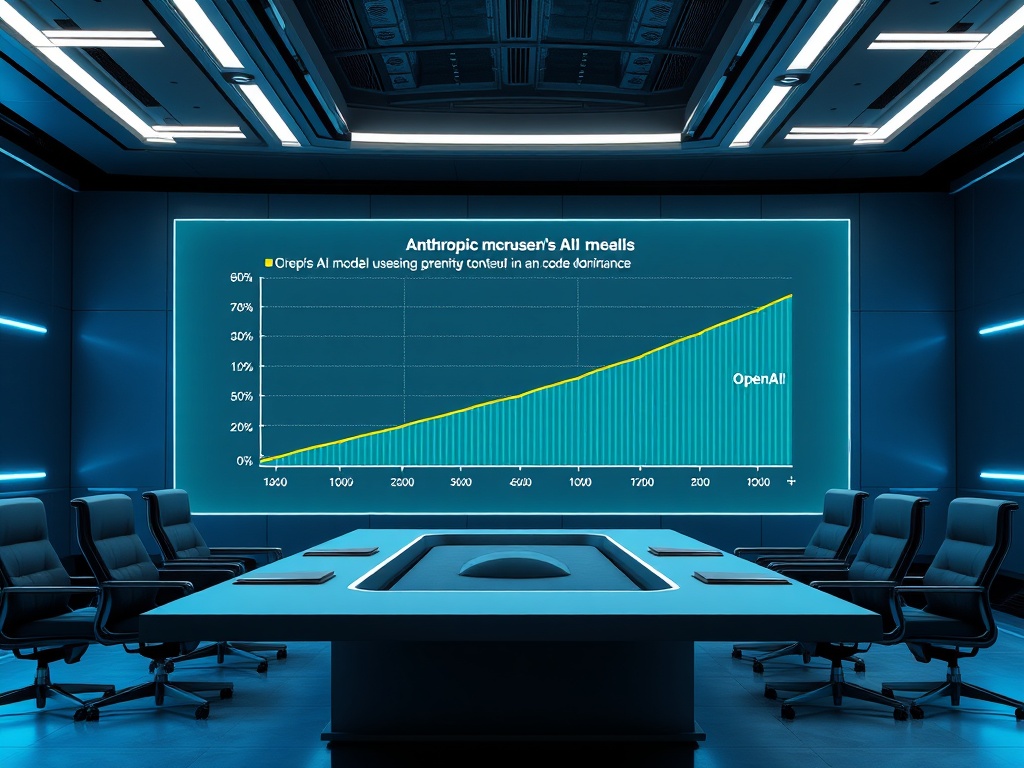BitcoinWorld

Anthropic AI’s Ascendant Dominance: Overtaking OpenAI in Enterprise AI Market Share
The landscape of artificial intelligence is undergoing a profound transformation, and for those tracking the pulse of technological innovation, the latest data reveals a compelling shift. In a surprising turn, Anthropic AI models have emerged as the leading choice for enterprises, eclipsing OpenAI in a significant market reversal. This pivotal development not only redefines the competitive dynamics of the AI sector but also offers crucial insights for businesses and investors navigating the rapidly evolving world of advanced technology.
Anthropic AI’s Ascendant Dominance: What’s Driving Enterprise Adoption?
According to a recent report from Menlo Ventures, Anthropic, the cutting-edge AI research lab, now commands an impressive 32% of the enterprise Large Language Model (LLM) market share by usage. This positions Anthropic firmly ahead of OpenAI, which holds the second-largest share at 25% among enterprises. This shift is particularly striking when viewed against the backdrop of just a couple of years ago.
In 2023, OpenAI was the undisputed leader, boasting a dominant 50% of the enterprise market. Anthropic, at that time, held a mere 12%. The intervening period has witnessed a dramatic and consistent reversal, with OpenAI’s enterprise share declining sharply as Anthropic’s has steadily climbed. This trend is not merely statistical; it aligns with growing anecdotal evidence from developers and startups who have increasingly voiced a preference for Anthropic’s Claude models over OpenAI’s offerings for their business applications.
A key factor in Anthropic’s rapid ascent is its remarkable stronghold in the domain of coding. The Menlo Ventures report highlights that Anthropic secures a staggering 42% of the enterprise market share for AI-assisted coding, more than double the 21% garnered by OpenAI in the same category. This specialized proficiency suggests that Anthropic’s models are perceived as superior or more finely tuned for the intricate demands of software development within large organizations.
This preference in coding isn’t just about raw performance; it often stems from factors like context window size, reduced “hallucinations” (generating factually incorrect or nonsensical information), and the ability to handle complex, multi-turn conversations essential for intricate programming tasks. Enterprises often require models that can maintain coherence and accuracy over extended interactions, a feature where Anthropic’s Claude models appear to excel.
Shifting AI Market Share: A New Leader Emerges
The foundation for Anthropic’s dramatic surge was reportedly laid with the strategic release of its Claude Sonnet 3.5 model in June 2024. This particular iteration seemingly hit a sweet spot for enterprise requirements, driving significant adoption. The momentum was further amplified by the subsequent introduction of Claude Sonnet 3.7 in February 2025, solidifying Anthropic’s position as a formidable leader in the enterprise AI space. This rapid iteration and successful deployment of new models underscore the fierce competition and the agility required to capture significant AI market share.
While Anthropic and OpenAI command the largest portions of the enterprise market, the ecosystem is not static. Google, for instance, has demonstrated consistent growth in enterprise usage for its AI models over recent years, indicating a broader diversification of choices available to businesses. This dynamic environment fosters continuous innovation, as companies vie for dominance by offering more robust, secure, and specialized AI solutions.
To better understand the current landscape, consider the following comparison of the two dominant players in the enterprise AI sphere:
| Feature | Anthropic (Claude) | OpenAI (ChatGPT Enterprise) |
|---|---|---|
| Enterprise LLM Market Share (Usage) | 32% (Leading) | 25% (Second) |
| Coding Market Share (Usage) | 42% (Dominant) | 21% |
| Key Strengths in Enterprise | Complex reasoning, longer context, reduced hallucinations, strong coding capabilities, enterprise-grade focus. | Broad applicability, strong general knowledge, API accessibility, early market mover advantage. |
| Consumer Market Presence | Growing but less dominant than enterprise. | Very strong (2.5B+ prompts/day for ChatGPT). |
| Recent Growth Trajectory | Steadily increasing since 2023. | Declining in enterprise since 2023. |
This table illustrates the strategic differentiation emerging between these AI giants. Anthropic’s focus appears to be on delivering deep, reliable capabilities for complex business operations, while OpenAI balances its enterprise efforts with a powerful, widely adopted consumer offering.
OpenAI’s Strategic Focus: A Look at the Consumer Side
While the narrative in the enterprise sector highlights OpenAI‘s receding market share, it is vital to contextualize this within their broader strategy. OpenAI continues to hold an unparalleled position in the consumer market. The company recently reported a staggering statistic: users send more than 2.5 billion prompts to ChatGPT every single day. This immense volume of interaction underscores ChatGPT’s pervasive influence and popularity among general consumers, students, and individual professionals.
This divergence in market strength—Anthropic leading enterprise, OpenAI dominating consumer—suggests a strategic segmentation. Enterprises typically demand higher levels of data privacy, security, customizability, and robust integration capabilities, often requiring dedicated support and compliance certifications. Anthropic’s development philosophy, often emphasizing “Constitutional AI” for safer and more aligned outputs, might resonate more with these stringent enterprise requirements.
Conversely, the consumer market prioritizes ease of access, intuitive user interfaces, and broad utility for everyday tasks, areas where ChatGPT has undeniably excelled. For businesses, understanding this distinction is crucial when selecting an AI partner. A model that performs well in a general consumer context might not possess the specific attributes—like handling proprietary data securely or performing highly specialized coding tasks—that an enterprise requires.
The Transformative Power of Large Language Models in Business
The Menlo Ventures report also sheds light on a broader, significant trend impacting Enterprise AI adoption: the pronounced preference for closed-source models. The findings indicate that more than half of the surveyed enterprises explicitly stated they do not utilize open-source models at all. Furthermore, the percentage of enterprise daily workloads relying on open-source models has notably decreased from 19% at the beginning of 2025 to a mere 13% by mid-year 2025. This strong inclination towards proprietary, often more secure, and commercially supported AI solutions from providers like Anthropic and OpenAI signals a maturing enterprise market where stability, security, and dedicated support are paramount.
Despite this overarching preference, Meta continues to maintain its leadership in the open-source AI market. This suggests that while the majority of enterprises opt for closed systems, a significant segment still values the flexibility, transparency, and community-driven innovation offered by open-source alternatives. The choice between open and closed models often involves a careful balance of factors: the desire for greater control and customization inherent in open-source solutions versus the robust support, security guarantees, and pre-trained capabilities typically found in closed models.
Regardless of the chosen model type, the benefits that advanced Large Language Models bring to the enterprise are undeniable and transformative:
- Enhanced Operational Efficiency: LLMs can automate a wide array of repetitive and complex tasks, from drafting reports and summarizing documents to generating code and responding to customer inquiries, significantly reducing manual effort and accelerating workflows.
- Accelerated Innovation: By providing powerful tools for research, design, and content generation, LLMs enable businesses to innovate faster, develop new products, and explore novel solutions with unprecedented speed.
- Superior Customer and Employee Experiences: Personalized chatbots, intelligent assistants, and advanced knowledge management systems powered by LLMs can deliver highly tailored and efficient interactions, boosting satisfaction for both customers and internal teams.
- Deeper Data-Driven Insights: LLMs can process and analyze vast quantities of unstructured data—such as customer feedback, market reports, and internal communications—to uncover valuable insights that inform strategic decision-making.
- Cost Optimization: Automation and efficiency gains brought by LLMs can lead to significant cost reductions in areas like customer support, content creation, and software development.
Navigating the Enterprise AI Landscape: Challenges and Opportunities
For businesses looking to implement or expand their Enterprise AI capabilities, the recent shifts in market dynamics, particularly Anthropic’s rise, provide critical insights. It’s clear that mere computational power is no longer the sole determinant of success; rather, it’s the ability of an LLM to seamlessly integrate into existing workflows, address specific industry challenges, and provide reliable, secure performance that truly drives adoption.
However, the journey of AI adoption within enterprises is not without its challenges:
- Data Privacy and Security: Handling sensitive proprietary data with AI models requires robust security protocols and adherence to evolving regulatory frameworks.
- Integration Complexity: Integrating LLMs into existing IT infrastructure and applications can be complex, requiring significant technical expertise and resources.
- Talent Gap: A shortage of skilled AI engineers and data scientists can hinder effective deployment and optimization of AI solutions.
- Cost Management: The computational resources required for large-scale LLM deployment and inference can be substantial, necessitating careful cost-benefit analysis.
- Ethical AI Governance: Ensuring fair, unbiased, and transparent AI operations is crucial to maintaining trust and avoiding reputational risks.
Actionable Insights for Strategic AI Adoption:
- Conduct a Thorough Needs Assessment: Before committing to an LLM provider, meticulously evaluate your specific business needs, use cases, and existing technical infrastructure. A general-purpose model might suffice for some tasks, while others demand specialized capabilities like those offered by Anthropic for coding.
- Prioritize Data Governance and Security: Given the strong preference for closed models, ensure your chosen AI partner offers robust data encryption, privacy controls, and compliance certifications relevant to your industry and region.
- Assess Integration Capabilities: Evaluate the ease of integration through APIs, SDKs, and compatibility with your current software ecosystem. A smooth integration process minimizes disruption and accelerates time-to-value.
- Invest in Pilot Programs: Before a full-scale rollout, implement pilot projects with different AI models to test their performance, accuracy, and efficiency against your specific key performance indicators (KPIs) in a controlled environment.
- Foster an AI-Ready Workforce: Invest in training and upskilling your teams to effectively leverage AI tools, understand their outputs, and adapt to new AI-driven workflows.
- Stay Informed and Agile: The AI market is characterized by rapid innovation. Continuously monitor new model releases, market trends, and competitive shifts to remain agile and adapt your AI strategy as needed.
The dynamic interplay between technological innovation, evolving market demands, and strategic business focus will undoubtedly continue to shape the enterprise AI landscape. Anthropic’s remarkable success serves as a potent reminder that in the fast-paced world of artificial intelligence, a deep understanding of specific user needs, coupled with rapid and effective model development, are paramount for achieving and maintaining market leadership.
In conclusion, the enterprise AI domain has witnessed a remarkable power shift, with Anthropic’s AI models now spearheading the charge, particularly in specialized and high-value areas such as coding. While OpenAI continues to hold an formidable position in the broader consumer market, Anthropic’s deliberate and effective focus on stringent enterprise requirements, bolstered by the success of its Claude Sonnet models, has propelled it to a leading position. This evolving competitive landscape underscores the critical importance for businesses to meticulously evaluate their AI partnerships, prioritizing solutions that not only align with their unique operational demands but also promise enhanced security, scalability, and long-term strategic advantage. The future of enterprise AI promises continued innovation and intense competition, ultimately benefiting businesses worldwide through more powerful and tailored AI capabilities.
To learn more about the latest AI market trends, explore our article on key developments shaping AI Models features.
This post Anthropic AI’s Ascendant Dominance: Overtaking OpenAI in Enterprise AI Market Share first appeared on BitcoinWorld and is written by Editorial Team





